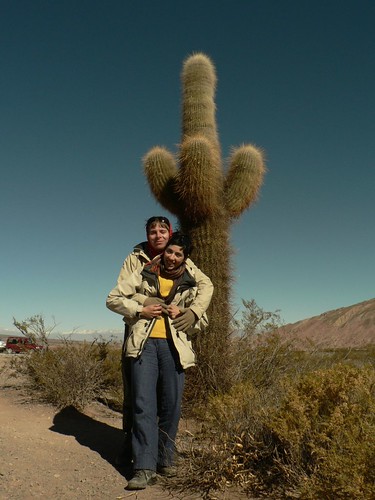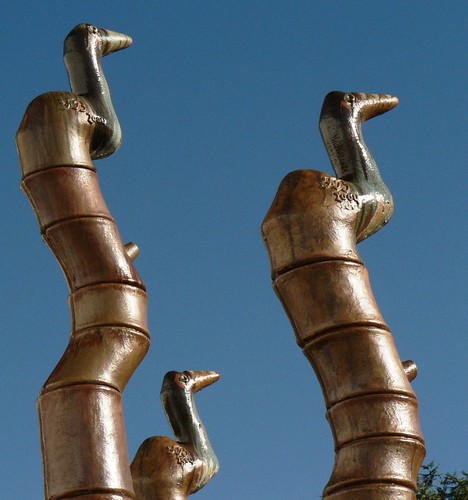
It’s been some time. Meanwhile we got to see San Juan, a small town on the east of Argentina. It is a good base town for a trip to Ischigualasto, known as The Moon Valley. Ischigualasto means dry land. It only gets 100mm rain per year, so its a high mountain desert. On the one day trip, where we made 700km, we met some animals: a posing fox, a shy guinea pig, and the interesting and elegant guanacos - who are among the most adaptable animals, comparable to camels. They get enough water from eating thick leaves and especially juicy is a plant called “cat foot” in the native language. The guanacos live only in the southern parts of the Andean mountain range, which means Chile and Argentina. They are almost extinct because they give nice wool, but at the same time they are not domesticated like lamas or alpacas.
Luckily the day was clear and warm as a result of the Zonda - warm wind from the mountains. It was surprisingly warm for the season, as both the week before and after the area had snow. The valley is a place of paleontological as well as geological interest. It has sediments and fossils from the Triassic period (around 200 million years ago) and the oldest known dinosaur skeletons were found there. However, for us the landscape was the most impressive. The colourful mountains and hills which eroded in interesting ways, sometimes looking like submarines or a sfinx, added spice to the tour. On this trip a policeman hitchhiked with us. He sat in the trunk half the way and kept our speedy driver cool.
In San Juan and the next stop Mendoza we were more laid back. Not because of all the wine production in the region, but mainly because of cold weather. Particularly in Mendoza we felt the need to supply ourselves with warmer clothes. The cold and boring weather prevented us from hiking in the surrounding mountains, which was really our purpose with visiting Mendoza. It is the nearest (tourist-friendly) city to the highest peak Anaconcuagua reaching around 6000m just at the border between Argentina and Chile. The warm Zonda wind was taking a break and snowfall was blocking the mountain roads over to Chile for 3 days. Bored of hanging around in Mendoza, we hurried up north in hope for warmth. Salta, indeed, welcomed us a bit warmer, however far from tropic heat. For this we will need to head to another country.
Salta – is the nicest city we have visited so far. Full of colonial buildings, cute parks but unfortunately also very touristified. As we came to Salta the day before the independence day of Argentina, it was full of local tourists. The city is crowded with tour agencies and there are also several good tourist offices. Tourist come mainly for mountain activities and skiing.
On the national holiday, the 9th of July, we had a great opportunity to see traditional local dresses in a parade just outside of Salta, in a village called Campo Quijano. The bus at 9 in the morning was crowded, and during the day we were the only foreigners there. Even the local radio tracked us down for a chat. We saw hundreds of kids dressed as grown-ups, as well as Gauchos – the herds on horses with red and black ponchos. It didn’t seem that people would proudly celebrate the independence day, but they mainly enjoyed the party and having a day off. In general Argentineans don’t get too passionate about things – neither history nor stuff. But it is true that everybody likes to talk about it, particulary about economical situation, corruption, and about being conservative and resistant to changes. They tend to criticise alot.
We spent two consecutive days in the mountains. The first day we went north of Salta, to the Humahuaca walley and visited Purmamarca. People in the village since recently live out of tourism, but earlier they used to be farmers with a small patch of land and maybe some goats. Their houses are built from adobe bricks (mud dried on sand) and the village streets are not paved. The village has an excellent view over the mountain of seven colours. Different minerals in contact with air leave majestic colours of sand, which from a distance looks like a shining painters palette.
In the same day we ascended to the highest point of our journey at 4220m on the way to the salt desert Salinas Grandes. We felt a bit dizzy because of the hight, but didn’t see any of soroche, the name for altitude sickness.
Salinas grandes reminded us of the value of tasty fresh water. We walked around the big white nothing, stomping salt crystals. Around Salta there were many other attractive places to visit. All of them are in one way or another connected to high mountain desert – puna.
A trip to Cachi – a tiny village on the Altiplano area offered us a nice day with Simona and Dusan, two Slovenes we met the previous day. On the way they were many sighs of wonder heard in the car, when three Slovenes were amazed by the mountains of many colours. In the high peaks we managed to spot a few condors, circling high up looking for possible prey. That day gave us the chance to walk among thousands of cactuses in the national park Cordones. A cactus with sun shining form behind made it look soft because the needles gave a blurry effect. The needles suck water from the air, and that’s good because the ground hasn’t got any water and it “never rains”.
Cafayate
One day we rented a car together with two young Argentineans from our hostel and made a trip to Cafayate, a 70 km long valley of colourful and curious stone formations. Our only driver handled the roads nicely. All over the countryside of Argentina we saw low traffic and straight roads, making it easy to drive. Another nice thing with Argentina is that natural parks are easily accessible.
 Enough of cold weather – back to Brazil! The road to Curitiba became complicated. Instead of waiting for next day and take a 40h direct ride, we took a chance to go half-way to Posadas and look for another ride there, maybe even the same day. Bad choice. Posadas is right on the way, but few buses stop there and it’s not tourist friendly or organized. Looking for a table in any restaurant during a football game between Argentina and Brazil took place was also really difficult. But we got good food, and Brazil won the American cup with boring 3-0. From Posadas we actually had to go via Iguacu on both sides of the border. We stopped ca 10 times for each town, and also in many villages, picking or dropping people all the way. At last in Foz on the Brazilian side we got lucky and got a last minute ticket on a direct bus to Curitiba within the hour of arriving.
Enough of cold weather – back to Brazil! The road to Curitiba became complicated. Instead of waiting for next day and take a 40h direct ride, we took a chance to go half-way to Posadas and look for another ride there, maybe even the same day. Bad choice. Posadas is right on the way, but few buses stop there and it’s not tourist friendly or organized. Looking for a table in any restaurant during a football game between Argentina and Brazil took place was also really difficult. But we got good food, and Brazil won the American cup with boring 3-0. From Posadas we actually had to go via Iguacu on both sides of the border. We stopped ca 10 times for each town, and also in many villages, picking or dropping people all the way. At last in Foz on the Brazilian side we got lucky and got a last minute ticket on a direct bus to Curitiba within the hour of arriving.


